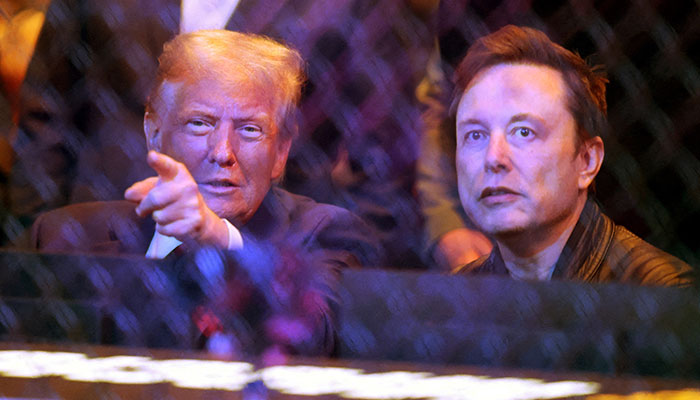Explainer: Why Trump seeks to restructure USAID?
USAID's top aid recipients in 2023 were Ukraine, Ethiopia, Jordan, DR Congo, Somalia, Yemen, Afghanistan
February 04, 2025

WASHINGTON: US President Donald Trump is planning to merge the country's international aid agency, USAID, into the State Department as part of a wider shake-up aimed at cutting staff and bringing aid spending in line with his "America First" policy.
Trump has entrusted Elon Musk, the billionaire heading his drive to shrink the federal government, to oversee the project. On Sunday, Trump said USAID had "been run by a bunch of radical lunatics, and we're getting them out," while Musk called it "a criminal organisation" without providing any evidence and said it was "time for it to die."
What is USAID and how is it funded?
USAID was established in 1961 by Democratic President John F. Kennedy at the height of the Cold War with the aim of better coordinating foreign assistance, already a key platform of US foreign policy in countering Soviet influence.
It now administers some 60% of US foreign assistance and disbursed $43.79 billion in fiscal 2023. According to a Congressional Research Service report this month, its workforce of 10,000, about two-thirds serving overseas, assisted about 130 countries. USAID is funded by Congress, based on administration requests.
CRS said USAID helps "strategically important countries and countries in conflict; leads US efforts to alleviate poverty, disease, and humanitarian need; and assists US commercial interests by supporting developing countries’ economic growth and building countries’ capacity to participate in world trade."
Its top aid recipients in 2023 were Ukraine, Ethiopia, Jordan, Democratic Republic of Congo, Somalia, Yemen, Afghanistan, Nigeria, South Sudan, and Syria.
How much does the US spend on aid and how does it compare?
In fiscal 2023, the United States disbursed a total of $72 billion in assistance worldwide and about 42% of all humanitarian aid tracked by the United Nations in 2024. The funds covered everything from women's health in conflict zones to access to clean water, HIV/AIDS treatments, energy security, and anti-corruption work.
In recent years, according to a Brookings Institution report from September, US aid spending has been around 0.33% of GDP. It peaked at 3% of GDP in the 1950s with the Marshall Plan programme to rebuild Europe after World War Two. During the Cold War, it ranged from 1% to a little less than 0.5%.
While the United States gives more official government aid than any other country, its contribution as a percentage of national income was at the bottom of the list for wealthy countries in 2020, according to figures from the Organisation for Economic Co-operation and Development.
In 2023, Norway topped the list at 1.09% of gross national income, while the United States lagged at 0.24%, along with Slovenia, the Czech Republic, and Spain.
Is support for foreign aid bipartisan?
According to Brookings, Democratic administrations and lawmakers have historically been more supportive than Republicans, but every post-war president, whether Democrat or Republican, has been a strong proponent of foreign aid—apart from Trump.
It noted that proposals by the first Trump administration to cut the US international affairs budget by one-third were rejected, as were attempts to delay parliamentary consideration of supplemental foreign aid legislation in 2024. And in a bipartisan vote in June, 80% of the members of the Republican-led House of Representatives rejected an amendment to eliminate foreign assistance from the fiscal 2025 budget.
Who has been running USAID?
Under former President Joe Biden, USAID was run by Irish-American diplomat Samantha Power, a self-professed idealist who served as UN ambassador under Barack Obama.
Its top priorities under its March 2023 Policy Framework were the climate crisis, stemming the tide of authoritarianism, and promoting inclusive economic growth and equal opportunities.
In an interview this month, Power highlighted the role of USAID in projecting US soft power.
"The best testament to USAID's contribution is the surge in PRC-backed and Russian-backed propaganda maligning USAID and our work around the world," she said, using the initials of China's official name, the People's Republic of China.
Trump opposition and impact
In a 20 Jan executive order announcing a 90-day pause in most foreign aid, Trump said the US "foreign aid industry and bureaucracy are not aligned with American interests and in many cases antithetical to American values."
"They serve to destabilise world peace by promoting ideas in foreign countries that are directly inverse to harmonious and stable relations internal to and among countries," it said.
In a memo, the administration urged USAID workers to join the effort to transform how Washington allocates aid in line with Trump's "America First" policy and threatened disciplinary action for ignoring the orders.
The actions rang alarm bells from refugee camps in Thailand to Ukraine war zones, with humanitarian organisations and UN agencies saying they could face drastic curbs on their ability to distribute food, shelter, and healthcare.
A source with knowledge of USAID's workings said folding it into the State Department would be a big departure.
USAID has in the past been able to provide humanitarian assistance to countries with which Washington has no diplomatic relations, including Iran and North Korea. This has sometimes helped build bridges, the source said, and the benefit could be lost if its operations were purely tied to political objectives.











